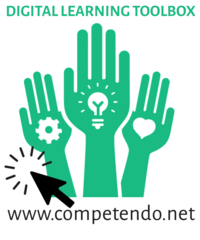|
|
| (7 intermediate revisions by the same user not shown) |
| Line 1: |
Line 1: |
| − | <div class="left-column-contentinner"> | + | <div class="methodpage-content"> |
| | <div style="float: right; width: 220px;"> | | <div style="float: right; width: 220px;"> |
| | [[File:Documentation.png | 200px | right]] | | [[File:Documentation.png | 200px | right]] |
| | </div> | | </div> |
| − | <div class=teaser-text>The reporting of a well-documented seminar is as easy as pie. Once you have all the learning aims, topics and methods noted down the reporting becomes a matter of incorporating your and participants' observations, feedback and recommendations into the existing document. Also, the more relevant details and insights that you have in the training documentation, the easier it becomes for you to share your experience with the new facilitators that might join your team. | + | <div class=teaser-text><div style="background: #eee; float: left; padding: 0px 5px 0px 5px; margin-right: 5px;"><i class="fas fa-arrow-left"> </i> [[After]]</div> The reporting of a well-documented seminar is as easy as pie. Once you have all the learning aims, topics and methods noted down the reporting becomes a matter of incorporating your and participants' observations, feedback and recommendations into the existing document. Also, the more relevant details and insights that you have in the training documentation, the easier it becomes for you to share your experience with the new facilitators that might join your team. |
| | </div> | | </div> |
| | ==Functions of Documentation== | | ==Functions of Documentation== |
| | Documentation happens in numerous ways. However, we consider too often only written reports as a tool for documentation, or photos of flipcharts. In fact documentation is much more. It's a post in a messenger group, it can be a drawing, a photo, a video, or a blog. Before deciding for a certain medium and documentation strategy, please remeber: Form should follow function: | | Documentation happens in numerous ways. However, we consider too often only written reports as a tool for documentation, or photos of flipcharts. In fact documentation is much more. It's a post in a messenger group, it can be a drawing, a photo, a video, or a blog. Before deciding for a certain medium and documentation strategy, please remeber: Form should follow function: |
| | <div class="mw-collapsible mw-collapsed" data-expandtext="Read more"> | | <div class="mw-collapsible mw-collapsed" data-expandtext="Read more"> |
| − | | + | <div class=left-box> |
| | ===Illustrating the Atmosphere=== | | ===Illustrating the Atmosphere=== |
| | * the location | | * the location |
| Line 18: |
Line 18: |
| | * learning goal achievement | | * learning goal achievement |
| | | | |
| − | ===Showing the Impact=== | + | ===Showing Impact=== |
| | * intellectual outcome | | * intellectual outcome |
| | * change in behavior and attitude | | * change in behavior and attitude |
| Line 34: |
Line 34: |
| | * content took place like planned | | * content took place like planned |
| | | | |
| | + | </div> |
| | </div> | | </div> |
| | | | |
| | | | |
| | <hr class=boldline> | | <hr class=boldline> |
| − | ==Articles, Checklists and Methods== | + | |
| | + | <div class=teaser-box> |
| | + | ===Articles, Checklists and Methods=== |
| | <div class="mw-collapsible mw-expanded" data-expandtext="Explore, what's inside!"> | | <div class="mw-collapsible mw-expanded" data-expandtext="Explore, what's inside!"> |
| − | <!-- <div class=teaser-box>
| |
| − | ===[[Functions of Documentation]]===
| |
| − | [[File:check.png | left]]Documentations have several functions. In order to find the right form, reflect the needs of organization and learner.
| |
| − | </div>
| |
| − | -->
| |
| − | <div class=teaser-box>
| |
| − |
| |
| − | ===[[Checklist: Report]]===
| |
| − | [[File:check.png | left]]One aim of this cheklist is to help you to give an overview about a seminar for persons, that were not at the seminar, especially clients. As well it helps a team to structure their evaluation process and helps to save findings, outcomes or aspects that have to be kept in mind for the future.
| |
| − | </div>
| |
| | | | |
| − | <!-- | + | <i class="far fa-check-square"></i> [[Checklist: Report]]<br> |
| − | <div class=teaser-box> | + | <i class="far fa-check-square"></i> [[Invoice]]<br> |
| | + | <i class="fas fa-cog"></i> [[Apps and Tools | Digital & Collaborative Documentation Tools]] |
| | | | |
| − | ===[[Digital & Collaborative Documentation Tools]]===
| |
| − | [[File:Method.png | left]]Digital tools allow us to share outcome of single sessions, easy and fast documentation of teamwork, or sharing links. As well we might plan our next program steps in an interactive way or evaluate things.
| |
| | </div> | | </div> |
| − | -->
| |
| − |
| |
| − | <div class=teaser-box>
| |
| − |
| |
| − | ===[[Invoice]]===
| |
| − | [[File:check.png | left]] Assistance for invoicing for your work as a freelancer..
| |
| | </div> | | </div> |
| | | | |
| | </div> | | </div> |
| − | </div>
| + | <div class="methodpage-infos"> |
| − | | + | <noinclude>{{:Navi After}}</noinclude> |
| − | <div class="right-column-contentinner"> | |
| − | | |
| − | ===Navigation:===
| |
| − | [[File:back.gif | back to the main section]] [[After]]
| |
| − | | |
| − | * [[Documentation in Trainings]]
| |
| − | <!-- | |
| − | **[[Functions of Documentation]]
| |
| − | **[[Checklist: Report]]
| |
| − | **[[Digital & Collaborative Documentation Tools]]
| |
| − | **[[Invoice]]
| |
| − | -->
| |
| | </div> | | </div> |


